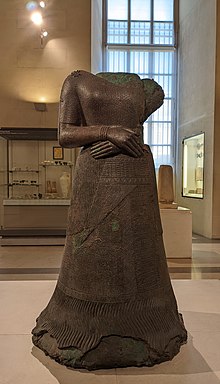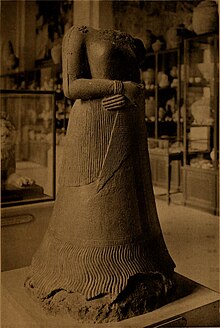| Napir-Asu | |
|---|---|
| Queen of Elam | |
 | |
| Reign | circa 1300 BC |
| Spouse | Untash-Napirisha |
Napir-Asu (fl. 14th century BCE) was an Elamite queen, who was the wife of King Untash-Napirisha. A statue of her by the bronzeworkers of Susa is one of the finest examples of bronze metal-working to be discovered.
Biography
It is likely that Napir-Asu corresponds to the daughter of the Babylonian Burnaburiash (perhaps the king Burna-Buraish II) married by Untash-Napirisha. A statue of the god Immiriya in Chogha Zanbil was dedicated by Napir-Asu's husband Untash-Napirisha to his father-in-law Burnaburiash. There is a letter that has survived which describes Untash-Napirisha marrying a daughter of a Burna-Buraish. However there is some debate as to whether the Burna-Burnish in the letter is in fact the king, or a later descendant.
Nevertheless it does appear that Napir-Asu was the first Elamite royal woman to be depicted on a limestone stele with her husband. She appears to also be the first Elamite queen whose name is inscribed on her body in statue form. The stele depicts Napir-Asu, Untash-Napirisha and his mother, the priestess Utik. Historians Esfandyar Rahmati Kia and Kolsoum Ghazanfari have argued that Napir-Asu held some power in her own right.
Statue

In 1903 archaeologist Jacques de Morgan, working as part of the Délégation scientifique française en Perse, discovered a 130cm high statue, made of a bronze core, covered by a layer of copper, with cast and chased decoration, weighing 1750 kg. It was found in the upper rooms of the temple of Ninhursag in Susa. It is also the largest example of Elamite bronze sculpture known. Since the statue was placed in the temple, curator Françoise Tallon has argued that the statue represented the queen in "perpetual prayer".
The statue was originally created with a series of processes that enabled the casting of its core and creation of its surface. The copper shell was created first by building a core of clay and bricks, which was then covered in wax, into which designs were made, followed by encasement in another layer of clay. Heated, so that the wax melted away, copper was then poured into the mould. Once the copper was cooled, the clay core was removed and layers of bronze were poured into the hollow of the body. At one time the surface may have been covered with gold and silver leaf. The statue's decorations are an important source for the study of Elamite textiles and clothing. The head and the left arm of the statue are missing.
On the fringed skirt of this statue, the names of the queen and the great gods of Susa are engraved in Elamite cuneiform. There is a ring on the queen's left hand, which is probably her wedding ring. On the skirt of this statue and in the language of the queen, a curse is written:
I, Napir-Asu, wife of Untash-Napirisha. He who would seize my statue, who would smash it, who would destroy its inscription, who would erase my name, may he be smitten by the curse of Napirisha, of Kiririsha, and of Inshushinak, that his name shall become extinct, that his offspring be barren, that the forces of Beltiya, the great goddess, shall sweep down on him. This is Napir-Asu's offering.
The statue is held in the Louvre collections. In 1993 the statue, alongside other works from the Louvre, was loaned to the Metropolitan Museum of Art for exhibition. It is recognised as a masterpiece of Elamite art.
Notes
- In the dedication, the part of the text mentioning the Babylonian king is damaged. In François Vallat's opinion, shared by Daniel T. Potts, i-ia-áš should be read as -bur-ia-áš; E. Reiner prefers a geographical interpretation, proposing i-ia-áš; according to other historians, the damaged text should be restored as i-ia-áš, actually referring to Kashtiliash IV.
References
- ^ Louvre, Musée du (1992). The Royal City of Susa: Ancient Near Eastern Treasures in the Louvre. Metropolitan Museum of Art. ISBN 978-0-87099-651-1.
- Quintana, Enrique (2010–2011). "Filiacion y acceso al trono en Elam (2ª Mitad II milenio a.c.)". Revue d'assyriologie et d'archéologie orientale. 104: 45–63. doi:10.3917/assy.104.0045.
- Potts, D. T. (April 2006). "Elamites and Kassites in the Persian Gulf". Journal of Near Eastern Studies. 65 (2). University of Chicago Press: 115. doi:10.1086/504986. S2CID 162371671.
- Potts, Daniel T. (2014). Elamite Monumentality and Architectural Scale - Lessons from Suda and Choga Zanbil. p. 29.
- ^ Álvarez-Mon, Javier; Basello, Gian Pietro; Wicks, Yasmina (2018-01-29). The Elamite World. Routledge. ISBN 978-1-317-32983-1.
- GOLDBERG, Jeremy (2004). "The Berlin Letter, Middle Elamite Chronology and Sutruk-Nahhunte I's Genealogy". Iranica Antiqua. 39: 33–42. doi:10.2143/IA.39.0.503891. ISSN 1783-1482.
- Rahmati Kia, Esfandyar; Ghazanfari, Kolsoum (2021-02-19). "The Political Position of Women in the Middle Elamite Period (1500-1100 B.C". Journal of Iran History (in Persian). 13 (2): 85–109. doi:10.52547/irhj.13.2.85. ISSN 2588-6916.
- Potts, D.; Harkness, Ethan; Neelis, Jason; McIntosh, Roderick, eds. (2021-09-20). The Encyclopedia of Ancient History: Asia and Africa (1 ed.). Wiley. doi:10.1002/9781119399919.eahaa00250. ISBN 978-1-119-39991-9. S2CID 244593546.
- ^ Potts, Daniel T.; Alcock, Susan (1999-07-29). The Archaeology of Elam: Formation and Transformation of an Ancient Iranian State. Cambridge University Press. pp. 210, 218. ISBN 978-0-521-56496-0.
- Budin, Stephanie Lynn; Turfa, Jean Macintosh (2016-08-12). Women in Antiquity: Real Women across the Ancient World. Routledge. ISBN 978-1-317-21990-3.
- Potts, D. T. (2012-08-15). A Companion to the Archaeology of the Ancient Near East. John Wiley & Sons. ISBN 978-1-4443-6077-6.
- Kleiner, Fred S. (2020-01-01). Gardner's Art through the Ages: The Western Perspective, Volume I. Cengage Learning. ISBN 978-0-357-37048-3.
- statue, 1345, retrieved 2022-05-23
- "Copper Topics #74 - 3,000 Year-Old Copper/Bronze Statue On Display". www.copper.org. Retrieved 2022-05-23.
- Gershevitch, I. (1985). The Cambridge History of Iran. Cambridge University Press. ISBN 978-0-521-20091-2.
- Saturday Review of Politics, Literature, Science and Art. John W. Parker and Son. 1905.
- Collini, Luca (2012-03-07). Copper Alloys: Early Applications and Current Performance - Enhancing Processes. BoD – Books on Demand. ISBN 978-953-51-0160-4.
- Foundation, Encyclopaedia Iranica. "Welcome to Encyclopaedia Iranica". iranicaonline.org. Retrieved 2022-05-23.